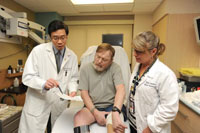Office of Research & Development |
 |


On a cool, crisp morning in mid-October, William Honse arrived at the Pittsburgh VA Medical Center for the first part of an experimental treatment he hopes will save his leg. The therapy will use Honse's own bone marrow, cultured to increase the counts of beneficial cells and then injected back into his leg.
Like one in five VA patients, the 60-year-old Army Veteran has diabetes. The disease has already taken a huge toll on Honse's health. Doctors had to amputate his left leg in January of this year. Skin sores on the bottom of his foot had led to a dangerous bone infection. Now, he is trying to ward off the same scenario in his right leg.
Even with the best wound care, people with advanced diabetes face the threat of amputation. Lack of sensation in their feet—the effect of dulled nerves—puts them at risk for skin wounds. Poor blood circulation keeps these wounds from closing up and healing. Bacteria or dirt that enters the wound can lead to limb-threatening infections, such as the one that took Honse's left leg. Those who are heavy smokers on top of having diabetes usually have the worst prognoses.
Because of his flagging overall health, Honse no longer has the option of surgery to improve the circulation in his leg.
"That's why Mr. Honse is in the trial," says study coordinator Jennifer Carrick, RN. "He can't have any more operations to improve circulation."
On Honse's mid-October visit, his doctor used a long, thin needle to draw out a small amount of soft, spongy bone marrow from inside his hip bone. The marrow was sent to the lab of a Michigan-based company called Aastrom Biosciences, which developed the new therapy, known as Ixmylocel-T.
The marrow was cultured in a special chamber for several days to expand the count of immune cells and adult stem cells. The goal, once the product is injected back into the patient, is to spur the growth of new blood vessels—thus increasing circulation—and to allow for better wound-healing.
VA investigators and other researchers helped lead an earlier, smaller trial of Ixmylocel-T that showed promising results. The findings were published in June 2012 in the journal Molecular Therapy.
In the study, 72 patients received either the real Ixmylocel-T treatment or a sham version. The results showed that the treatment was well-tolerated and led to a 62-percent drop in the risk of treatment failure. Treatment failure was any of four events: amputation of the infected leg, death from any cause, doubling of total wound surface, or new-onset gangrene. The patients were followed for a year.
The Pittsburgh VA's Edith Tzeng, MD, who helped conduct the earlier trial, says, "There was not really a measurable improvement in blood flow to the extremity, but the impact on wound healing was great." She says the results helped researchers plan the new trial with "more of a focus on wound healing and less on examining blood flow." Either way, she says she is hopeful the technology will help Veterans and others threatened with limb loss because of poor wound-healing and blood circulation.
"If the therapy can improve wound healing through either promoting angiogenesis [the growth of new blood vessels] or by having a direct impact on the wound, then it could improve limb salvage or at least delay the need for amputation," says Edith Tzeng, MD, lead investigator for the Ixmylocel-T study in Pittsburgh. Seven other VA sites are taking part, along with dozens of non-VA hospitals nationwide. More than 500 patients are expected to take part. All will have a condition known as critical limb ischemia, the most severe form of peripheral arterial disease, putting them at risk for amputation. Many, like Honse, will also have diabetes as a complicating factor.
Two weeks after his first study visit, Honse returned to the VA medical center for a series of painless injections in his right leg, starting from the mid-thigh and going down to his foot. He received 20 injections in all.
Meanwhile, his care team is tending to a dime-sized sore on the sole of his foot.
"He gets his dressing changed daily," says Kelly Garbelotti, NP, a nurse practitioner who is overseeing Honse's wound care. "We've also used ultrasound wound debridement [a process for cleaning out a wound], and compression therapy to treat his edema"—swelling due to fluid build-up.
All the patients in the trial—whether they get the new cell therapy or a placebo—receive the same state-of-the-art wound care. The cell therapy is an extra measure, and doctors will watch closely over 18 months to see if the Ixmylocel-T patients do better than the standard-care group: Will their wounds heal better, and will they be less likely to need amputation?
Because the clinical trial is "double blinded," neither Honse nor his doctors and nurses know whether his injections contained a real Ixmylocel-T treatment, made from his own bone marrow, or a look-alike placebo. At this point, that information is known only to the local VA pharmacist involved in the trial.
Honse's sister, Louann Taggart, accompanies the Veteran to all his medical appointments and helps him out at home. She says he intends to remain optimistic about his outcome, regardless of whether he's actually receiving the cell therapy or not. "He's planning to wait and see," she says.